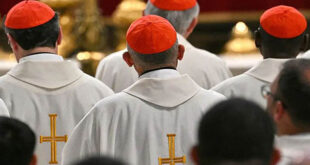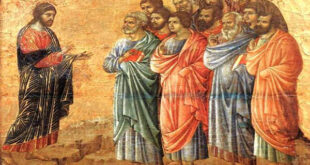The Agnus Dei, or “Lamb of God,” is one of the most powerful and evocative images in Christian faith. This expression, used in Catholic liturgy, is loaded with profound theological and spiritual meaning. It is not just a reference to Christ, but encapsulates the essence of redemptive sacrifice, divine mercy, and the call to eternal life.
In the context of the Mass, the invocation of the Agnus Dei occurs just before Communion, when the faithful recognize Jesus as the Lamb who gave Himself for the salvation of the world. It is a brief, yet profound prayer that invites us to humility and to acknowledge our dependence on God’s grace.
This article aims to delve into the meaning of the Agnus Dei, its theological and spiritual relevance, and offers practical ideas on how to integrate this concept into daily life. We will explore its history, its roots in Sacred Scripture, and how its symbolism remains a powerful guide for Christians today.
History and Biblical Context
The concept of the “Lamb of God” dates back to the deepest roots of the Christian faith and holds central significance in Scripture, both in the Old and New Testaments.
The Lamb in the Old Testament
In salvation history, the lamb has special significance from ancient times. One of the most emblematic passages is found in the Book of Exodus when God commands the Israelites to sacrifice a lamb without blemish and smear its blood on the doorposts during the night of the Passover (Exodus 12). This act of sacrifice was a sign for the angel of death to pass over the houses marked with the lamb’s blood, thus saving the firstborns of Israel. The Passover lamb, therefore, became a symbol of liberation and salvation.
Another significant passage is the story of the sacrifice of Isaac, in which God provides a ram for Abraham to sacrifice in place of his son (Genesis 22:13). In this narrative, the lamb again symbolizes the substitute sacrifice that God Himself offers.
The Lamb in the New Testament
The symbolism of the lamb reaches its fullness in the New Testament, specifically in the figure of Jesus Christ. In the Gospel of John, John the Baptist proclaims Jesus’ identity with the words: “Behold the Lamb of God, who takes away the sin of the world” (John 1:29). This statement is key to understanding Christ’s mission. By calling Him the “Lamb of God,” John identifies Jesus as the fulfillment of all the Old Testament prophecies and sacrifices. Jesus is the ultimate Passover Lamb, who gives Himself as a sacrifice to redeem humanity from sin.
The Book of Revelation is also full of references to the “Lamb” (Revelation 5:6-14), depicting Him as the one worthy to open the sealed book and as the center of heavenly worship. The Lamb is shown as glorified, yet bearing the marks of His sacrifice, highlighting the connection between Christ’s redemption and His atoning sacrifice.
The Liturgy of Agnus Dei
The phrase Agnus Dei was formally introduced into Catholic liturgy in the 7th century during the papacy of Sergius I. It is sung or recited during the breaking of the bread at Mass, just before Communion. At this crucial moment in the liturgy, the faithful acknowledge their need for mercy and the peace that comes from Christ, the Lamb sacrificed for our sins.
The Agnus Dei is recited three times, each time asking Christ to have mercy on us and, finally, to grant us peace: “Lamb of God, who takes away the sins of the world, have mercy on us… grant us peace.” These words invite us to participate in Christ’s sacrifice and to receive His peace, recognizing His role as the redeeming Lamb.
Theological Relevance
The Agnus Dei carries profound theological significance, leading us to the heart of the Christian mystery of redemption.
The Redemptive Sacrifice
The Agnus Dei highlights Christ’s sacrifice on the cross as the central act of redemption. Just as the Passover lamb in the Old Testament was sacrificed for the salvation of Israel’s firstborns, Jesus Christ, the spotless Lamb, offered Himself as a sacrifice for the sins of the whole world. This sacrifice not only frees us from sin but opens the doors to eternal life.
Christ’s sacrifice as the Lamb of God is unique because it is a perfect and definitive sacrifice. Through His death and resurrection, Jesus not only redeems humanity but also establishes a new relationship between God and man, one based on grace, forgiveness, and unconditional love.
The Lamb as a Symbol of Humility and Meekness
The lamb is an animal that symbolizes innocence, meekness, and submission. By calling Himself the “Lamb of God,” Jesus provides the supreme example of humility and obedience to the Father’s will. He did not come into the world to wield power with violence but to offer Himself in sacrifice out of love. This humility is a fundamental lesson for Christians, who are called to follow Christ’s example in their own lives by practicing meekness and selfless giving to others.
Divine Mercy
In each recitation of the Agnus Dei, we ask for mercy. This highlights another essential theological aspect: God’s mercy. Jesus, the Lamb of God, is the embodiment of that mercy. Through His sacrifice, we are forgiven and called to live in His grace. The mercy we ask for is not something we earn but a free gift that God bestows on us through the sacrifice of His Son.
Practical Applications
Reflection in the Mass
During the celebration of the Mass, the moment when the Agnus Dei is sung or recited is a profound opportunity for reflection. At this moment, the faithful are invited to acknowledge their need for mercy and prepare their hearts to receive Christ in the Eucharist. A practical way to integrate this moment into daily life is to pause from routine to reflect on the immensity of Christ’s sacrifice and the mercy we receive through Him.
Practicing Humility and Service
The example of the Lamb of God invites us to practice humility in our daily lives. In a world that often values competition and power, the Agnus Dei reminds us that true greatness lies in humility and selfless service. Christians can integrate this lesson into their daily lives by seeking opportunities to serve others, especially those in need, without expecting anything in return.
Mercy and Forgiveness
Reciting the Agnus Dei calls us to be agents of mercy and forgiveness in our personal relationships. Just as Christ, the Lamb of God, has forgiven us, we are also called to forgive those who have wronged us. In daily life, this means being willing to let go of offenses, heal broken relationships, and practice active forgiveness.
Contemporary Reflection
The message of the Agnus Dei remains relevant in today’s world. In a society marked by division, conflict, and the pursuit of power, the Lamb of God offers a radical alternative: the path of peace, humility, and mercy.
Peace in a Broken World
The final petition of the Agnus Dei is for Christ to grant us peace. This plea for peace is especially relevant in the modern world, where political, social, and economic tensions often lead to conflict. The peace that Christ offers is not simply the absence of war but a deep peace that arises from a heart reconciled with God. Christians are called to be instruments of that peace in the world, promoting reconciliation, dialogue, and justice in their communities.
Mercy in Times of Judgment
We live in an era where judgment and condemnation, especially on social media, have become common. The Agnus Dei invites us to a different approach: instead of judging, we are called to practice mercy. In daily life, this means adopting an attitude of compassion towards others, recognizing that we are all sinners in need of God’s grace.
Conclusion
The Agnus Dei is much more than a liturgical prayer; it is a constant reminder of Christ’s redemptive sacrifice and His infinite mercy. As we reflect on its theological meaning, its relevance in the Christian life, and the practical ways we can live it, we are called to a life of humility, service, and forgiveness.
May each time we recite or hear the Agnus Dei, our hearts be open to God’s mercy, and may we carry that mercy into the world, acting as agents of peace and love in a world that so desperately needs it.






